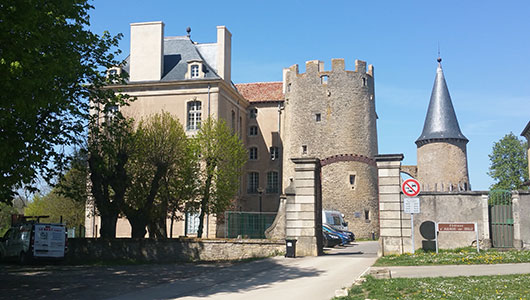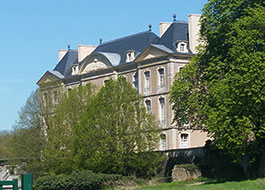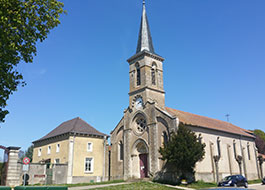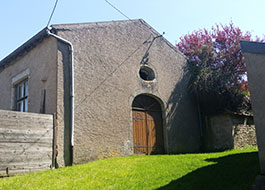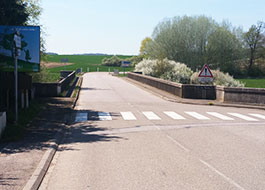Aulnois-sur-Seille
Durée visite : 40 minutes
Moyen : Pédestre
Situé dans le Saulnois, le territoire communal d’Aulnois-sur-Seille est situé sur la rive droite de la Seille. L’occupation du site remonte à la Préhistoire. Une nécropole mérovingienne a été mise à jour au début du XXe siècle. Les premières mentions du village apparaissent au XIIe siècle : Alnet, du latin alnus, aune, et du suffixe etum, aulnaie, avec distinctif de site ; puis Anoit (1211), Aunoi (1229), Ennoy (1329), nom qui évolue en Aunois puis Aulnoy-sur-Seille au XVIIIe siècle et son nom actuel depuis 1924. Au Moyen Âge, le pont d’Aulnois su la Seille revêt une importance capitale et son passage était assujetti à un droit de péage. Le village appartient au ban de Delme, un domaine épiscopal comprenant en outre les villages d’Alaincourt, Craincourt, Fossieux, Lemoncourt, Manhoué, Puzieux et Xocourt. À la fin du XIVe siècle, le ban est engagé par l’évêque de Metz, Raoul de Coucy, au duc de Lorraine. Siège d’une maison forte depuis le XIVe siècle (et non au VIIIe siècle comme l’indique certaines sources), le fief d’Aulnois relevait du marquisat de Pont-à-Mousson, qui souffrit beaucoup des rigueurs de la guerre de Trente Ans et subit la guerre, la famine et la peste. En 1635, Aulnois est en grande partie détruit.
Located in the Saulnois, the municipal territory of Aulnois-sur-Seille is located on the right bank of the Seille. The occupation of the site dates back to prehistoric times. A Merovingian necropolis was uncovered at the beginning of the 20th century. The first mentions of the village appear in the 12th century (1121 and 1180): Alnet, from the Latin alnus, aune, and the suffix etum, aulnaie, with distinctive site; then Anoit (1211), Aunoi (1229), Ennoy (1329), a name that evolved into Aunois then Aulnoy-sur-Seille in the 18th century and its current name since 1924. In the Middle Ages, the Aulnois bridge on the Seille covered of capital importance and its passage was subject to a toll. The village belongs to the Ban de Delme, an episcopal domain further comprising the villages of Alaincourt, Craincourt, Fossieux, Lemoncourt, Manhoué, Puzieux and Xocourt. At the end of the 14th century, the ban was hired by the Bishop of Metz, Raoul de Coucy, to the Duke of Lorraine. Seat of a fortified house since the 14th century (and not in the 8th century as some sources indicate), the fief of Aulnois came under the marquisate of Pont-à-Mousson, who suffered greatly from the rigors of the Thirty Years’ War and endures war, famine and pestilence. In 1635, Aulnois was largely destroyed.
Das Gemeindegebiet von Aulnois-sur-Seille befindet sich in Saulnois am rechten Ufer der Seille. Die Besetzung des Ortes geht auf prähistorische Zeiten zurück. Eine merowingische Nekropole wurde zu Beginn des 20. Jahrhunderts freigelegt. Die ersten Erwähnungen des Dorfes erscheinen im 12. Jahrhundert (1121 und 1180): Alnet aus dem lateinischen alnus aune und das Suffix etum aulnaie mit unverwechselbarer Stelle; dann Anoit (1211), Aunoi (1229), Ennoy (1329), ein Name, der sich im 18. Jahrhundert zu Aunois und dann zu Aulnoy-sur-Seille entwickelte und seit 1924 seinen heutigen Namen trägt. Im Mittelalter bedeckte die Aulnois-Brücke auf der Seille von Kapitalbedeutung und sein Durchgang war gebührenpflichtig. Das Dorf gehört zum Verbot von Delme, einer bischöflichen Domäne, die die Dörfer Alaincourt, Craincourt, Fossieux, Lemoncourt, Manhoué, Puzieux und Xocourt umfasst. Ende des 14. Jahrhunderts wurde das Verbot vom Bischof von Metz, Raoul de Coucy, an den Herzog von Lothringen übertragen. Das Lehen von Aulnois war seit dem 14. Jahrhundert Sitz eines befestigten Hauses (und nicht im 8. Jahrhundert, wie einige Quellen belegen) und unterstand dem Marquisat von Pont-à-Mousson, der stark unter den Strapazen des Dreißigjährigen Krieges litt und erträgt Krieg, Hunger und Pest. 1635 wurde Aulnois weitgehend zerstört.

D’argent à la fasce de sable, au lion léopardé de gueules en chef.
Ce sont les armes des plus anciens seigneurs d’Aulnois-sur-Seille au Moyen âge.
Argent a fess Sable, to the lion leopard Gules in chief.
These are the weapons of the oldest lords of Aulnois-sur-Seille in the Middle Ages.
Argent a fess Sable an den Löwenleoparden Gules.
Dies sind die Waffen der ältesten Herren von Aulnois-sur-Seille im Mittelalter.

La Cloche du Capucin.
Au temps des Croisades, un seigneur des Armoises partit pour la Terre sainte, accompagné de son chapelain qui était un moine capucin. Pour sauver la vie à son seigneur, tombé au pouvoir des Sarrazins, le moine leur livra sa tête, et Dieu permit qu’en récompense de cet acte, qui le rendait martyr de la foi chrétienne et victime de son dévouement, il revint de temps à autre à Aulnois. Il y apparaissait dans l’escalier de la Grande Tour, le capuchon rabattu, portant entre ses mains son cou tranché par le glaive du Turc; et ainsi il montait lentement jusqu’au sommet, pour y sonner la cloche, qui y est encore aujourd’hui. Or, cela avait lieu chaque fois qu’un malheur menaçait d’atteindre la famille des Armoises. (N’oublions pas que les Capucins n’ont été fondés que vers 1527).
Réf. Austrasie, 1912, p. 258
The Capuchin Bell.
At the time of the Crusades, a lord of Armoises left for the Holy Land, accompanied by his chaplain who was a Capuchin monk. To save the life of his lord, who had fallen into the power of the Saracens, the monk gave his head to them, and God allowed that as a reward for this act, which made him a martyr of the Christian faith and a victim of his devotion, he returned from time to another in Aulnois. He appeared there in the staircase of the Great Tower, his hood pulled down, carrying in his hands his neck cut off by the Turk’s sword; and so he slowly climbed to the top, to ring the bell there, which is still there today. However, this took place each time a misfortune threatened to reach the Armoises family. (Let us not forget that the Capuchins were not founded until around 1527).
Ref. Austrasia, 1912, p. 258
Die Kapuzinerglocke.
Zur Zeit der Kreuzzüge reiste ein Herr der Waffen in das Heilige Land, begleitet von seinem Kaplan, der ein Kapuzinermönch war. Um das Leben seines Herrn zu retten, der in die Macht der Sarazenen gefallen war, gab der Mönch ihnen seinen Kopf, und Gott erlaubte dies als Belohnung für diese Tat, die ihn zum Märtyrer des christlichen Glaubens und zum Opfer seiner Hingabe machte zu einem anderen in Aulnois. Er erschien dort auf der Treppe des Großen Turms, die Kapuze heruntergezogen, und in den Händen den vom Türkenschwert abgeschnittenen Hals. und so kletterte er langsam nach oben, um dort die Glocke zu läuten, die heute noch da ist. Dies geschah jedoch jedes Mal, wenn ein Unglück die Familie Armoises zu erreichen drohte. (Vergessen wir nicht, dass die Kapuziner erst um 1527 gegründet wurden).
Ref. Austrasia, 1912, p. 258
Les points de visites
.
A la fin du XVIe s., Antoinette d’Oriocourt apporta le château d’Aulnois à Nicolas des Armoises, son mari. Leurs descendants le conservèrent jusqu’en 1772. Comme toutes les forteresses lorraines, Aulnois souffrit beaucoup de la guerre de Trente ans. Dans les années 1680, Paul des Armoises y fit faire d’importantes réparations. Son fils Charles obtint en 1726 que sa terre fût érigée en marquisat. Et sans tarder, il entreprit de réaliser un château neuf. Il en demanda les plans à Germain Boffrand. Celui- ci fut l’élève de Mansart. Il construisit le château de Lunéville. Peu habité par ses propriétaires, le château d Aulnois se dégrada assez rapidement. En 1772, il fut acquis par Michel-Joseph de Coeurderoy, premier président de la Cour souveraine de Lorraine. Des réaménagements intérieurs furent faits au milieu du XIXe siècle. De 1863 à 1870, d’importants travaux furent exécutés dans la cour, la terrasse et le parc. A la veille de la Seconde Guerre mondiale, le château fut vendu à une congrégation religieuse qui y établit un internat. Il souffrit beaucoup de son utilisation par les Jeunesses hitlériennes entre 1940 et 1944. Les combats de la Libération le dégradèrent aussi.
En reconstruisant Aulnois en 1726, on maintint une partie importante du château ancien. La construction de Boffrand le cache au regard. On ne le découvre qu’en accédant à la cour intérieure. Ces parties anciennes composent le côté Nord-Est du château. Elles comprennent essentiellement une grosse tour ronde à cinq niveaux du XIVe siècle, une tour carrée renfermant la chapelle castrale et un corps de bâtiment,daté du XVIe siècle, dont on n’a conservé que la structure extérieure. La façade de Boffrand, au Sud-Ouest, domine la vallée de la Seille. Longue de 45 m, divisée en onze travées, haute de trois niveaux, elle a un avant-corps central à fronton cintré. A l’intérieur, tous les niveaux anciens, à l’exception de ceux des tours, avaient été modifiés, afin de mettre l’ensemble à l’unisson de la façade du XVIIIe s. Le corps de bâtiment du XVIe siècle, vidé de son contenu, forma la cage d’un vaste escalier. Il subsiste quelques parties, très remaniées, de l’enceinte médiévale de la cour. Au Sud-Ouest, un escalier à double révolution permet de descendre de la terrasse à un parterre.
At the end of the 16th century, Antoinette d’Oriocourt brought the Château d’Aulnois to Nicolas des Armoises, her husband. Their descendants kept it until 1772. Like all the Lorraine fortresses, Aulnois suffered greatly from the Thirty Years’ War. In the 1680s, Paul des Armoises had major repairs made there. His son Charles obtained in 1726 that his land be set up as a marquisate. And without delay, he set out to build a new castle. He asked Germain Boffrand for the plans. The latter was a pupil of Mansart. He built the castle of Lunéville. Little inhabited by its owners, the castle of Aulnois deteriorated quite quickly. In 1772, it was acquired by Michel-Joseph de Coeurderoy, first president of the Sovereign Court of Lorraine. Interior renovations were made in the middle of the 19th century. From 1863 to 1870, major works were carried out in the courtyard, the terrace and the park. On the eve of the Second World War, the castle was sold to a religious congregation which established a boarding school there. It suffered greatly from its use by the Hitler Youth between 1940 and 1944. The Liberation battles also degraded it.
By rebuilding Aulnois in 1726, an important part of the old castle was maintained. Boffrand’s construction hides it from view. You can only discover it by accessing the interior courtyard. These old parts make up the northeast side of the castle. They mainly include a large round tower on five levels from the 14th century, a square tower containing the castle chapel and a building, dating from the 16th century, of which only the outer structure has been preserved. The facade of Boffrand, to the south-west, dominates the valley of the Seille. 45 m long, divided into eleven bays, three levels high, it has a central front section with an arched pediment. Inside, all the old levels, with the exception of those of the towers, had been modified, in order to bring the whole in unison with the facade of the 18th century. The 16th century building, emptied of its contents, formed the cage of a vast staircase. There are still some parts of the medieval courtyard walls, very altered. To the south-west, a double spiral staircase leads down from the terrace to a flowerbed.
Ende des 16. Jahrhunderts brachte Antoinette d’Oriocourt das Château d’Aulnois zu Nicolas des Armoises, ihrem Ehemann. Ihre Nachkommen behielten es bis 1772. Wie alle lothringischen Festungen litt Aulnois stark unter dem Dreißigjährigen Krieg. In den 1680er Jahren ließ Paul des Armoises dort größere Reparaturen durchführen. Sein Sohn Charles erhielt 1726 die Einrichtung seines Landes als Marquisat. Und ohne Verzögerung machte er sich daran, ein neues Schloss zu bauen. Er bat Germain Boffrand um Pläne. Letzterer war ein Schüler von Mansart. Er baute das Schloss von Lunéville. Das von seinen Besitzern wenig bewohnte Schloss von Aulnois verfiel ziemlich schnell. 1772 wurde es von Michel-Joseph de Coeurderoy, dem ersten Präsidenten des Souveränen Gerichts von Lothringen, erworben. Die Innenrenovierung erfolgte Mitte des 19. Jahrhunderts. Von 1863 bis 1870 wurden größere Arbeiten im Innenhof, auf der Terrasse und im Park durchgeführt. Am Vorabend des Zweiten Weltkriegs wurde die Burg an eine religiöse Gemeinde verkauft, die dort ein Internat errichtete. Es litt stark unter seiner Verwendung durch die Hitlerjugend zwischen 1940 und 1944. Die Befreiungsschlachten erniedrigten es auch.
Durch den Wiederaufbau von Aulnois im Jahr 1726 wurde ein wichtiger Teil der alten Burg erhalten. Boffrands Konstruktion verbirgt es vor der Sicht. Sie können es nur entdecken, wenn Sie den Innenhof betreten. Diese alten Teile bilden die Nordostseite des Schlosses. Sie umfassen hauptsächlich einen großen runden Turm auf fünf Ebenen aus dem 14. Jahrhundert, einen quadratischen Turm mit der Schlosskapelle und ein Gebäude aus dem 16. Jahrhundert, von dem nur die äußere Struktur erhalten geblieben ist. Die Fassade von Boffrand im Südwesten dominiert das Tal der Seille. 45 m lang, in elf Buchten unterteilt, drei Ebenen hoch, hat es eine zentrale Front mit einem gewölbten Giebel. Im Inneren waren alle alten Ebenen mit Ausnahme der Türme modifiziert worden, um das Ganze mit der Fassade des 18. Jahrhunderts in Einklang zu bringen. Das Gebäude aus dem 16. Jahrhundert, dessen Inhalt geleert wurde, bildete den Käfig einer riesigen Treppe. Es gibt noch einige Teile der mittelalterlichen Innenhofmauern, die sehr verändert sind. Im Südwesten führt eine doppelte Wendeltreppe von der Terrasse zu einem Blumenbeet.
.
.
L’église d’Aulnois est de style néo-roman. Elle date de 1860.
L’Exaltation de la précieuse et vivifiante Croix est une fête. Elle est est célébrée le 14 septembre. Selon une tradition largement répandue, la Vraie Croix fut découverte en 326 par sainte Hélène. Elle était la mère de l’empereur Constantin le Grand. Elle effectuait alors un pèlerinage à Jérusalem. Par ordre d’Hélène et de Constantin, l’église du Saint-Sépulcre fut bâtie sur le lieu de la découverte. L’église, conservant une portion de la Croix fut consacrée neuf ans plus tard. Une légende raconte qu’en 614, cette relique fut dérobée et emportée par les Perses. Reconquise en 618 par l’empereur byzantin Héraclius, elle fut d’abord rapportée à Constantinople puis renvoyée plus tard à Jérusalem.
Quelques dictons sont liés à cette fête.
- A la Sainte-Croix, cueille tes pommes et gaule tes noix.
- Qui n’a pas semé à la Sainte Croix au lieu d’un grain en mettra trois.
The church of Aulnois is neo-Romanesque style. It dates from 1860.
The Exaltation of the precious and vivifying Cross is a feast. It is celebrated on September 14. According to a widely held tradition, the True Cross was discovered in 326 by Saint Helena. She was the mother of Emperor Constantine the Great. She was then making a pilgrimage to Jerusalem. By order of Helena and Constantine, the Church of the Holy Sepulcher was built on the site of the discovery. The church, retaining a portion of the Cross, was consecrated nine years later. A legend has it that in 614, this relic was stolen and taken away by the Persians. Reconquered in 618 by the Byzantine emperor Heraclius, it was first brought back to Constantinople and later returned to Jerusalem.
Some sayings are linked to this holiday.
- At the Holy Cross, pick your apples and sapling your nuts.
- Whoever has not sown at the Holy Cross instead of a seed will put three.
Die Kirche von Aulnois ist im neoromanischen Stil. Es stammt aus dem Jahr 1860.
Die Erhöhung des kostbaren und belebenden Kreuzes ist ein Fest. Es wird am 14. September gefeiert. Nach einer weit verbreiteten Tradition wurde das Wahre Kreuz 326 von der Heiligen Helena entdeckt. Sie war die Mutter von Kaiser Konstantin dem Grossen. Sie pilgerte gerade nach Jerusalem. Im Auftrag von Helena und Konstantin wurde an der Stelle der Entdeckung die Grabeskirche errichtet. Die Kirche, die einen Teil des Kreuzes behielt, wurde neun Jahre später geweiht. Eine Legende besagt, dass dieses Relikt 614 von den Persern gestohlen und weggebracht wurde. 618 vom byzantinischen Kaiser Heraklius zurückerobert, wurde es zunächst nach Konstantinopel zurückgebracht und später nach Jerusalem zurückgebracht.
Einige Sprüche sind mit diesem Feiertag verbunden.
- Pflücken Sie am Heiligen Kreuz Ihre Äpfel und schäumen Sie Ihre Nüsse.
- Wer nicht anstelle eines Samens am Heiligen Kreuz gesät hat, setzt drei.
.
L’ordre des Hospitaliers de Saint-Jean de Jérusalem, de Rhodes et de Malte, connu généralement dès le XIIe siècle sous le nom d’ordre hospitalier de Saint-Jean de Jérusalem, construit une chapelle dit de Saint-Jean d’Aulnoy établie dès le XIIIe siècle et placée sous le patronage de Notre-Dame. Restauré en 1910-1913 et désaffecté aujourd’hui, le chœur carré date du XVIe siècle et possède un oculus, une piscine et une clé de voûte aux armes de Malte. La nef date de 1692. Une demande de protection auprès des monuments historiques est en cours.
The Order of Hospitallers of St. John of Jerusalem, Rhodes and Malta, generally known from the 12th century under the name of the Hospitaller Order of St. John of Jerusalem, built a chapel known as of St. John of Aulnoy established from the 13th century and placed under the patronage of Notre-Dame. Restored in 1910-1913 and disused today, the square choir dates from the 16th century and has an oculus, a swimming pool and a keystone bearing the arms of Malta. The nave dates from 1692. A request for protection from historic monuments is in progress.
Der Orden der Hospitalisten von Johannes von Jerusalem, Rhodos und Malta, allgemein bekannt ab dem 12. Jahrhundert unter dem Namen des Hospitalierordens von Johannes von Jerusalem, errichtete eine Kapelle, die als Johannes von Aulnoy bekannt ist aus dem 13. Jahrhundert und unter der Schirmherrschaft von Notre-Dame gestellt. Der 1910-1913 restaurierte und heute stillgelegte quadratische Chor stammt aus dem 16. Jahrhundert und verfügt über ein Okulus, ein Schwimmbad und einen Schlussstein mit den Armen Maltas. Das Kirchenschiff stammt aus dem Jahr 1692. Ein Antrag auf Schutz vor historischen Denkmälern ist in Bearbeitung.
.
Le pont sur la Seille d’Aulnois a non seulement revêtu une grande importance au Moyen Âge mais aussi jusqu’au XXe siècle. Il a fait office de « pont-frontière » entre France et Allemagne pendant près d’un demi-siècle : 1870-1818 et 1940-1944, conflit au cours duquel il fut détruit pour ralentir la progression des troupes américaines. Avant le pont se trouvait donc un poste frontière.
The bridge over the Seille d’Aulnois was not only of great importance in the Middle Ages, but also until the 20th century. It served as a « border bridge » between France and Germany for nearly half a century: 1870-1818 and 1940-1944, a conflict in which it was destroyed by slowing the advance of American troops. Before the bridge there was therefore a border post.
Die Brücke über die Seille d’Aulnois war nicht nur im Mittelalter, sondern auch bis ins 20. Jahrhundert von großer Bedeutung. Es diente fast ein halbes Jahrhundert lang als « Grenzbrücke » zwischen Frankreich und Deutschland: 1870-1818 und 1940-1944, ein Konflikt, in dem es durch die Verlangsamung des Vormarsches amerikanischer Truppen zerstört wurde. Vor der Brücke befand sich daher ein Grenzposten.

